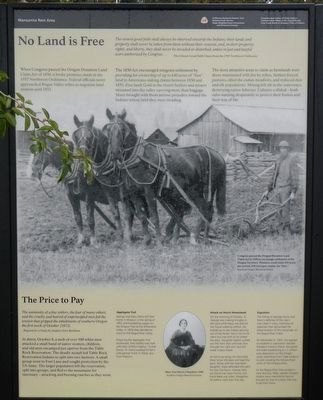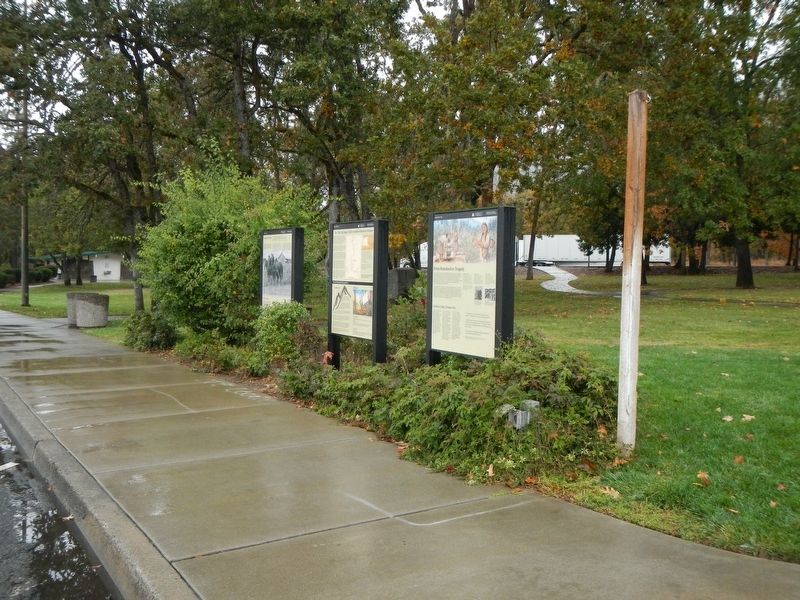Grants Pass in Josephine County, Oregon — The American West (Northwest)
No Land is Free

Photographed By Barry Swackhamer, September 21, 2017
1. No Land is Free Marker
Captions: (middle) Congress passed the Oregon Donation Land Claim Act in 1850 to encourage settlement of the Oregon Territory. Pioneers could claim 320 acres per person, 640 acres per couple, for “free.”; (center bottom) Mary Ann Harris Chambers 1860.
When Congress passed the Oregon Donation Land Claim Act of 1850, it broke promises made in the 1787 Northwest Ordinance. Federal officials never approached Rogue Valley tribes to negotiate land cession until 1853.
The 1850 Act encouraged emigrant settlement by providing for ownership of up to 640 acres of “free” land to Americans staking claims between 1850 and 1855. Free land! Gold in the rivers! Settlers and miners streamed into the valley carrying more than baggage. Many brought with them intense prejudice toward the Indians whose land they were invading.
The most attractive areas to claim as farmlands were those maintained with fire by tribes. Settlers fenced pastures, tilled the camas meadows, and reduced deer and elk populations. Mining left silt in the waterways, destroying native fisheries. Cultures collided—both sides wanting desperately to protect their homes and their way of life.
The animosity of a few settlers, the fear of many others, and the cruelty and hatred of unprincipled men fed the tension that gripped the inhabitants of southern Oregon the first week of October [1855]. -- Requiem for a People by Stephen Dow Beckham
At dawn, October 8, a mob of over 100 white men attacked a small band of native women, children, and old men encamped just upriver from the Table Rock Reservation. The deadly assault led Table Rock Reservation Indians to split into two factions. A small group went to Fort Lane and sought protection by the US Army. The larger population left the reservation, split into groups, and fled to the mountains for sanctuary—attacking and burning ranches as they went.
George and Mary Harris left their home in Missouri in the spring of 1852 and traveled by wagon on the Oregon Trail to the Willamette Valley. In 1854 they decided to move to the Rogue River Valley.
Following the Applegate Trail southward, they settled near here with their children Sophia, 13 and David, 10. Harris worked his farm with partner Frank A. Reed, also from Missouri.
On the morning of October, 9, George was making shingles in the yard while Mary was behind the house washing
clothes. He looked up to see Indians pouring out of the forest. Harris ran to his cabin but was shot as he closed the door. Daughter Sophie rushed out the front door and was shot through her right arm, but she made it back inside.
As Harris lay dying, he instructed Mary to bar the door and load the guns. Alone with her wounded daughter, Mary defended the cabin for over five hours. George died, son David was never found, and Frank Reed was killed. Altogether, 30 settlers were slain that day.
The killing of George Harris and Mary’s defense of the cabin was cited in many motivational speeches that demanded the extermination of the remainder of the Rogue River tribes.
On November 9, 1855, the request to establish a reservation reached President Franklin Pierce. He signed the order establishing a 1.1 million- acre reservation on the Oregon coast, extending from Cape Lookout to and including the Siltcoos River north of the Umpqua River.
As the Rogue River Wars ended in June and July 1856, western Oregon Indians were marched by land or brought by ship to a place that was to be their home.
Erected by National Park Service U.S. Department of the Interior; Hugo Neighborhood Association and Historical Society; Confederated Tribes of Siletz Indians; Confederated Tribes of the Grande Ronde; Cow Creek Band of Umpqua Tribe of Indians.
Topics and series. This historical marker is listed in these topic lists: Native Americans • Settlements & Settlers • Wars, US Indian. In addition, it is included in the Former U.S. Presidents: #14 Franklin Pierce series list. A significant historical month for this entry is July 1856.
Location. 42° 31.02′ N, 123° 21.798′ W. Marker is in Grants Pass, Oregon, in Josephine County. Marker can be reached from Interstate 5 at milepost 62 near Merlin Road, on the right when traveling north. Touch for map. Marker is in this post office area: Grants Pass OR 97526, United States of America. Touch for directions.
Other nearby markers. At least 8 other markers are within 7 miles of this marker, measured as the crow flies. The 1846 Applegate Trail (a few steps from this marker); Burrell M. Baucom (a few steps from this marker); From Homeland to Tragedy (a few steps from this marker); Rogue River Wars (approx. 2.9 miles away); The Oregon Cavemen (approx. 4.3 miles away); The First Brick Building in Grants Pass (approx. 5.7 miles away); The Perkinsville Ferry (approx. 6.2 miles away); Fort Vannoy (approx. 6.2 miles away). Touch for a list and map of all markers in Grants Pass.
More about this marker. The marker is at the Manzanita Rest Area, Northbound, located about a mile north of the Grants Pass/Merlin Road exit #61.
Credits. This page was last revised on August 3, 2020. It was originally submitted on January 16, 2018, by Barry Swackhamer of Brentwood, California. This page has been viewed 301 times since then and 29 times this year. Photos: 1, 2. submitted on January 16, 2018, by Barry Swackhamer of Brentwood, California.
